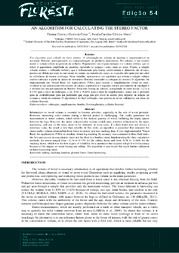An algorithm for calculating the stereo factor.
An algorithm for calculating the stereo factor.
Author(s): COSTA, T. C. e C. da; ABREU, N. C. O.
Summary: RESUMO - Um algoritmo para cálculo do fator estéreo. A informação do volume de madeira é imprescindível na atividade florestal, principalmente na comercialização de produtos madeireiros. No entanto, é um desafio medir o volume sólido no período da colheita. O parâmetro viável para medição é o volume estéreo, que se refere à quantidade empilhada de madeira, incluindo os espaços vazios entre as toras. Porém, a relação volume estéreo – cubicado (sólido), que é influenciada pela forma, uniformidade e dimensão das árvores, precisa ser obtida por meio de um ensaio de campo, na maioria dos casos, se o usuário não optar por um valor de referência, de menor confiança. Neste trabalho, apresenta-se um algoritmo que estima a relação volume estéreo-cubicado a partir de dados do inventário florestal associados a cubagem de árvores. O algoritmo foi implementado em Visual Basic for Applications (VBA) para simular o empilhamento virtual de toras. Avaliou-se sua acurácia em três ensaios de campo, o primeiro e o segundo em um povoamento de eucalipto e o terceiro em um povoamento de Bambu. Pelas três formas de cálculo, a amplitude de erros foi de -12.34 a 8.33% para o fator de cubicação, e de -8.94 a 15.64% para o fator de empilhamento, sendo este o primeiro grau de confiabilidade para um parâmetro que exige um alto nível de acerto, pelo impacto na relação de compra e venda de madeira. O algoritmo é de fácil utilização, mas precisa de novas validações, em áreas de colheita florestal. ABSTRACT- Information on wood volume is essential in forestry activities, especially in the sale of wood products. However, measuring solid volume during a harvest period is challenging. The viable parameter for measurement is stereo volume, which refers to the stacked quantity of wood, including the empty spaces between the logs. However, the stereo volume–cubic volume (solid) ratio, which is influenced by the taper, uniformity, and size of the trees, needs to be obtained. In most cases, if a field tester does not choose a reference value, the result is less than reliable. In this work, an algorithm is presented that estimates the stereo–cubic volume relationship from forest inventory and tree stacking data. It was implemented in Visual Basic for Applications (VBA) to simulate virtual log stacking. Its accuracy was evaluated in three field trials: the first and second in a eucalyptus stand and the third in a bamboo stand. Implementing the three calculation methods, the errors ranged from -12.34 to 8.33% for the cubing factor and from -8.94 to 15.64% for the stacking factor, which was the first degree of reliability for a parameter that requires a high level of accuracy because of the impact on wood buying and selling. The algorithm is easy to use but needs further validation in forest harvesting areas.
Publication year: 2024
Types of publication: Journal article
Unit: Embrapa Maize & Sorghum
Keywords: Bamboos, Bambu, Cubicação, Cubing, Empilhamento, Floresta plantada, Forest harvesting, Planted forest, Stacking
Observation
Some of Embrapa's publications are published as ePub files. To read them, use or download one of the following free software options to your computer or mobile device. Android: Google Play Books; IOS: iBooks; Windows and Linux: Calibre.
Access other publications
Access the Agricultural Research Database (BDPA) to consult Embrapa's full library collection and records.
Visit Embrapa Bookstore to purchase books and other publications sold by Embrapa.

